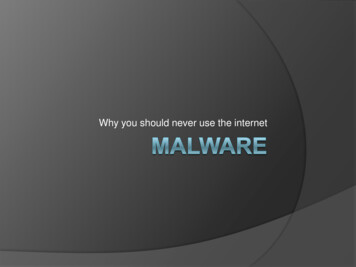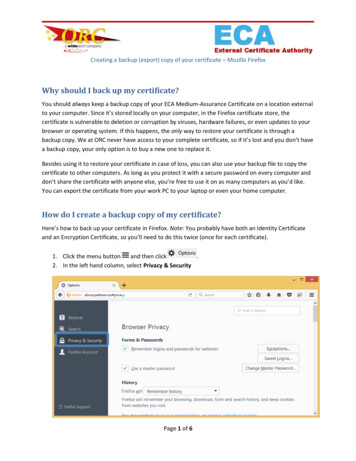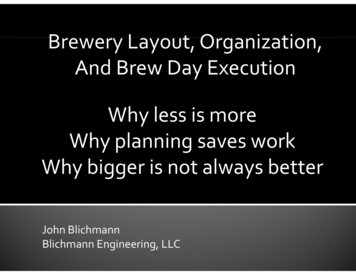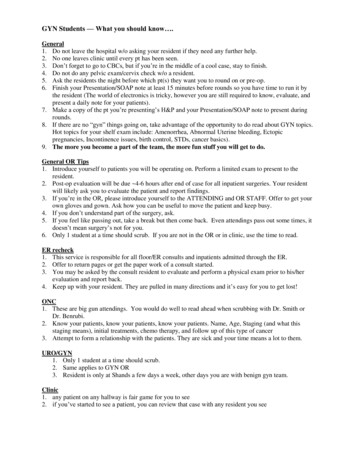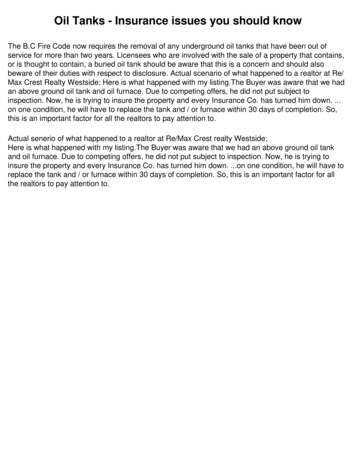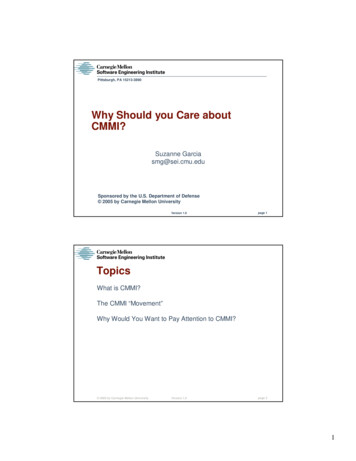
Transcription
Pittsburgh, PA 15213-3890Why Should you Care aboutCMMI?Suzanne Garciasmg@sei.cmu.eduSponsored by the U.S. Department of Defense 2005 by Carnegie Mellon UniversityVersion 1.0page 1TopicsWhat is CMMI?The CMMI “Movement”Why Would You Want to Pay Attention to CMMI? 2005 by Carnegie Mellon UniversityVersion 1.0page 21
What do we typically do whenproblems in product developmentarise?IgnoranceDenialis blissAIIEEE!Not a good method for problem solving 2005 by Carnegie Mellon UniversityVersion 1.0page 3Brief Characterization of “CMMI”CMMI (Capability Maturity Model Integration) is . A framework of management, engineering, and supportbest practices organized into 25 topics, called ProcessAreas An approach to improving the capability of any of the 25Process Areas by incrementally applying a set ofGeneric Practices that enhance the functioning of anindividual process Best thought of as a set of “process requirements” thathelp guide an organization who is defining andimplementing processes related to the 25 topics NOT a pre-defined, implementable “as is” processdefinition 2005 by Carnegie Mellon UniversityVersion 1.0page 42
How is CMMI Different from OtherProcess Reference Models?In contrast to most other reference models used for processimprovement, CMMI: Emphasizes and supports improving processes throughinstitutionalization practices- These are called generic practices- These are practices that can be applied to anyprocess of interest in an evolutionary fashion Emphasizes changes in observable behavior Emphasizes evolution, not just binary compliance Adoption isn’t “all or nothing”; pieces of the model can beapplied individually to accrue particular business benefits 2005 by Carnegie Mellon UniversityVersion 1.0page 5What Is Institutionalization?Institutionalization involves implementing practices that Ensure processes can be communicated about (they aredefined, documented, understood) Ensure the processes are effective, repeatable andlasting Provide needed infrastructure support Enable organizational learning to improve the process 2005 by Carnegie Mellon UniversityVersion 1.0page 63
Why is InstitutionalizationImportant?Without institutionalization Process improvement may not relate to business goals Processes will not be executed or managed consistently The processes will not survive staff or leadershipchanges The organization will find itself continuously “reinventingthe wheel” Commitment to provide resources or infrastructure tosupport or improve the processes will be missing orinsufficient Historical data will not be useful to support futureprojects 2005 by Carnegie Mellon UniversityModel RepresentationsContinuous for a single process area orset of process areas for a pre-defined set of processareas across an organizationMaturity Level 5CL55Optimizing: Focus onProcess Improvement4Quantitatively Managed: ProcessMeasured and Controlled3Defined: Process Characterizedfor the Organization andIs Proactive2Managed: ProcessCharacterized for Projectsand Is Often ReactiveOID, CARCL4Maturity Level 4OPP, QPMCL3Maturity Level 3RD, TS, PI, VER, VAL, OPF, OPD, OT,IPM, RSKM, DAR, OEI, IT, ISMCL2Maturity Level 2CL1(Initial)Process Area CapabilityStagedpage 7Version 1.0REQM, PP, PMC, MA, PPQA, CM, SAMPAMaturity Level 1zPA yCL0(Incomplete)PAxInitial: Process Unpredictable, Poorly Controlled, and ReactiveEssentiallyEssentially thethe SameSame ContentContent butbut OrganizedOrganized inin aa DifferentDifferent Way.Way. 2005 by Carnegie Mellon UniversityCopyright 2003, CSSA, Inc. Used with permission.Version 1.0page 84
CMMI Process AreasStagedContinuousProcess AreasProcess AreasLEVEL 5Project ManagementOrganizational Innovation & Deployment (OID)Causal Analysis and Resolution (CAR)Quantitative Project Management (QPM)Integrated Project Management (IPM)Risk Management (RSKM)Integrated Teaming (IT)Integrated Supplier Management (ISM)Project Planning (PP)Project Monitoring and Control (PMC)Supplier Agreement Management (SAM))LEVEL 4Organizational Process Performance (OPP)Quantitative Project Management (QPM)LEVEL 3Requirements Development (RD)Technical Solution (TS)Product Integration (PI)Verification (VER)Validation (VAL)Organizational Process Focus (OPF)Organizational Process Definition (OPD)Organizational Training (OT)Integrated Project Management (IPM)Risk Management (RSKM)Decision Analysis and Resolution (DAR)Organizational Environment for Integration (OEI)Integrated Teaming (IT)Integrated Supplier Management (ISM)Process ManagementOrganizational Innovation & Deployment (OID)Organizational Process Performance (OPP)Organizational Process Focus (OPF)Organizational Process Definition (OPD)Organizational Training (OT)EngineeringRequirements Management (REQM)Requirements Development (RD)Technical Solution (TS)Product Integration (PI)Verification (VER)Validation (VAL)LEVEL 2SupportRequirements Management (REQM)Project Planning (PP)Project Monitoring and Control (PMC)Measurement and Analysis (MA)Process and Product Quality Assurance (PPQA)Configuration Management (CM)Supplier Agreement Management (SAM) 2005 by Carnegie Mellon UniversityCausal Analysis and Resolution (CAR)Decision Analysis and Resolution (DAR)Organizational Environment for Integration (OEI)Measurement and Analysis (MA)Process and Product Quality Assurance (PPQA)Configuration Management (CM)page 9Version 1.0Generic Goals And PracticesLevelGeneric GoalsGeneric PracticesGG1: AchieveSpecific GoalsGP 1.1: Perform Base PracticesCL 2GG2: Institutionalizea Managed ProcessGP 2.1: Establish an Organizational PolicyGP 2.2: Plan the ProcessGP 2.3: Provide ResourcesGP 2.4: Assign ResponsibilityGP 2.5: Train PeopleGP 2.6: Manage ConfigurationsGP 2.7: Identify and Involve Relevant StakeholdersGP 2.8: Monitor and Control the ProcessGP 2.9: Objectively Evaluate AdherenceGP 2.10: Review Status with Higher Level ManagementCL3GG3: Institutionalizea Defined ProcessGP 3.1: Establish a Defined ProcessGP 3.2: Collect Improvement InformationCL4GG4: Institutionalizea QuantitativelyManaged ProcessGP 4.1: Establish Quantitative Objectives for the ProcessGP 4.2: Stabilize Subprocess PerformanceCL5GG5: Institutionalizean OptimizingProcessGP 5.1: Ensure Continuous Process ImprovementGP 5.2: Correct Root Causes of ProblemsCL 1ML 2ML 3ML 4ML 5 2005 by Carnegie Mellon UniversityCopyright 2003, CSSA, Inc. Used with permission.Version 1.0page 105
Pittsburgh, PA 15213-3890The CMMI “Movement”Sponsored by the U.S. Department of Defense 2005 by Carnegie Mellon Universitypage 11Version 1.0Organizational SizeBased on the total number of employees within the area of the organizationthat was appraised1001 to 20006.3%2000 3.7%25 or fewer10.3%501 to 10009.6%26 to 5012.8%301 to 50010.1%1 to 10040.9%201 to 2000 40.7%51 to 759.9%101 to 20018.5%201 to 30010.9%76 to 1007.9%Based on 861 organizations reporting size data 2005 by Carnegie Mellon University9/30/05Version 1.0page 126
Countries where Appraisals have beenPerformed and Reported to the SEIArgentinaAustraliaBelarusChinaGermanyKorea, Republic ofPortugalSwitzerlandVietnamColombia Czech RepublicHong Kong yEgyptIsraelNetherlandsSouth AfricaUkraineFinlandFranceItalyJapanNew Zealand PhilippinesSpainSwedenUnited Kingdom United StatesPurple country name: new additions with this reporting since Nov. 2004 2005 by Carnegie Mellon UniversityVersion 1.0Chile9/30/05page 13Maturity Profile by All ReportingUSA and Non-USA Organizations100%90%USA: 100 % 35580%Non-USA: 100 % 523% 510%3016611250%Not GivenInitialManagedBased on 355 USA organizations and 523 Non-USA organizations 2005 by Carnegie Mellon UniversityVersion ge 147
CMMI Transition Status – 9/30/051TrainingIntroduction to CMMI – 38,891 trainedIntermediate CMMI – 1,738 trainedIntroduction to CMMI Instructors – 372SCAMPI Lead Appraisers – 577 trainedAuthorizedIntroduction to CMMI V1.1 Instructors – 290SCAMPI V1.1 Lead Appraisers – 398 2005 by Carnegie Mellon UniversityVersion 1.0page 15Pittsburgh, PA 15213-3890Why Should You Pay Attention toCMMI?Sponsored by the U.S. Department of Defense 2005 by Carnegie Mellon UniversityVersion 1.0page 168
Performance Results SummaryImprovementsMedia # of rSatisfaction14%510%55%Return onInvestment3:182:113 : 1 N 18, as of 5 March 2005 (out of total N 26) Organizations with results expressed as change over time 2005 by Carnegie Mellon UniversityVersion 1.0page 17When Project Planning isn’t donewell What you’ll see Poor estimates that lead to cost and schedule overruns Unable to discover deviations from undocumented plans Resources aren’t available/applied when needed Unable to meet commitmentsWhy Should You Care? Because . Customers don’t trust suppliers who waste theirresources -- loss of future business No lessons learned for future projects means making thesame mistakes on multiple projects Unhappy customers, employees ,and stockholdersmeans a short life for the business If you fail to plan then you plan to fail! 2005 by Carnegie Mellon UniversityVersion 1.0page 189
When Project Monitoring andControl isn’t done well .What you’ll see Crisis management High rework levels throughout the project Lots of time spent in meetings trying to “discover” projectstatus rather than reporting on it Data needed for management decisions is unavailable whenneeded Actions that should have been taken early on aren’t discovereduntil it’s too lateWhy Should You Care? Because . If you don’t know what’s going on, corrective action can’t betaken early when it’s least expensive Lack of management insight/oversight makes project resultshighly unpredictable, even later in the project If your confidence in the status you give to your customer islow, they probably perceive that! 2005 by Carnegie Mellon UniversityVersion 1.0page 19When Requirements Managementisn’t done well .What you’ll see: High levels of re-work throughout the project Requirements accepted by staff from any source they deem tobe authoritative “Galloping” requirements creep Inability to “prove” that the product meets the approvedrequirementsWhy Should You Care? Because . Lack of agreement among stakeholders as to what are the“real” requirements increases time and cost to complete theproject You’re highly likely to deliver an incorrect or incompleteproduct Revisiting requirements changes over and over is a waste ofresource highly visible to the customer 2005 by Carnegie Mellon UniversityVersion 1.0page 2010
When ConfigurationManagement isn’t done well What you’ll see: Baseline system can’t be produced when needed Rework during test because components are not what wasexpected Complete inventory of system components unavailable whenneeded- Causes wasted time to find parts and specs and interfaces Uncontrolled changes that lead to uncontrolled reworkWhy Should You Care? Because Not knowing what is in the product leads to embarrassingdiscussions with customers Inability to rebuild/revisit a previous baseline wastes money andresources during maintenance Not being able to verify that the product tested is the productdelivered costs you time, effort, and customer confidence If you don’t know what’s in or out of the product, you don’t knowwhat you don’t know! 2005 by Carnegie Mellon UniversityVersion 1.0page 21When RequirementsDevelopment isn’t done well What you’ll see: Unstated requirements, poorly stated requirements that lead toconfusion among staff and customers Design, implementation, and test work products thatinconsistently interpret the requirements Inordinately long time to get to agreement on product designWhy Should You Care? Because Unusable products and unhappy customers lead to loss offuture business Wasted time and resources building product to requirementsthat customer may not want threatens your profitability Staff get tired of re-doing work because the requirements havebeen re-interpreted “yet again” The potential for excessive spending to meet customerexpectations increases when you don’t identify requirementswell 2005 by Carnegie Mellon UniversityVersion 1.0page 2211
I could go on .Backup slides contain similar slides for several other CMMI PAs,for when you can’t sleep at night .How does CMMI help overcome these kinds of problems? If you have no clue how to get started- Staged representation gives you a suggestion of whatthings other organizations have found helpful to work onfirst If you have a good handle on your business goals- You can use the Continuous representation to create acustomized improvement program that aligns with yourbusiness goals In either case- The practices in the Process Areas plus the GenericPractices provide a framework for an ongoing process ofcontinuous improvement 2005 by Carnegie Mellon UniversityVersion 1.0page 23Pittsburgh, PA 15213-3890Backup SlidesSponsored by the U.S. Department of Defense 2005 by Carnegie Mellon UniversityVersion 1.0page 2412
When Process and Product QualityAssurance aren’t done well What you’ll see: No assurance is available that quality standards are followedor achieved Poor quality work products being produced Ineffective processes that staff avoid using No accountability for not following process or meetingstandards Significant project issues are not escalated for managementattentionWhy Should You Care? Because Loss of management insight into development process cancause significant issues to be missed Poor quality interim products reduce customer’s confidencethat you can provide a high quality delivered product- You’re likely to lose that customer’s business in future 2005 by Carnegie Mellon UniversityVersion 1.0page 25When Supplier AgreementManagement isn’t done well Symptoms: Sub-optimal Supplier selection– not based on the right criteria Integration of supplier products into product baseline isproblematic Management and technical staff do not have insight intosupplier’s activities Supplier issues are not uncovered in a timely manner Supplier products are accepted even when they don’t meet theproduct requirementsWhy Should You Care? Because . A supplier can make or break your project You are ultimately responsible to your customer for supplierperformance 2005 by Carnegie Mellon UniversityVersion 1.0page 2613
When Measurement andAnalysis isn’t done well What you’ll see: Measurements unknowingly used inappropriately/ out ofcontext Management by perception/judgment vs. by fact Measurement presentations being used to confuse ratherthan enlighten Useless measures being collectedWhy Should You Care? Because Poor decisions that cannot be justified reduce customerand staff confidence Collected measures don’t allow you to quantify how closeyou are to meeting your business goals Having no valid basis for prioritizing improvements couldlead you to significant wasted overhead time, effort, money High risk for not meeting customer expectations wrt.delivery/quality of product 2005 by Carnegie Mellon UniversityVersion 1.0page 27When Technical Solution isn’tdone well What you’ll see: Less than optimal solution is “settled on” Products that don’t meet technical performancerequirements and/or user needs Increased testing/rework to resolve design/architectureissues Customer is surprised at the solution that resulted fromtheir requirementsWhy Should You Care? Because Increased cost to test and to address rework Future business is at risk with the customer ifperformance expectations aren’t met Product may not be able to accommodate technologyupgrades and future growth if technical solution isn’t wellconceived 2005 by Carnegie Mellon UniversityVersion 1.0page 2814
When Product Integration isn’tdone well .What you’ll see: Subsystems don’t operate together Increased integration/test time Building test harnesses/procedures/etc late in the project Integration environment is inadequate to support theintegration activitiesWhy Should You Care? Because . You can’t release the system until it operates as a unit You’ll spend more time in integration/test than youplanned/can afford You can’t accurately estimate integration-related costs,reducing your customer’s confidence There’s nothing quite as embarrassing as installing aproduct that doesn’t integrate with the customer’s system 2005 by Carnegie Mellon UniversityVersion 1.0page 29When Verification isn’t donewell .What you’ll see: Disagreement among technical staff as to the “done-ness” ofdifferent components Product under test doesn’t meet requirements/designexpectations Defects that could have been caught early escape into later lifecycle phases Increased integration/test timeWhy Should You Care? Because . Product reliability suffers if defects aren’t detected/ correctedprior to customer release Product costs more to test if early verification activities areignored Customers don’t want to pay for defective products- You probably won’t get their business next time 2005 by Carnegie Mellon UniversityVersion 1.0page 3015
When Validation isn’t donewell .What you’ll see: Lots of user change requests before/soon after theproduct is released Arguments among the technical staff as to what the user“really” wants Released product doesn’t meet user expectationsWhy Should You Care? Because . Customers don’t want to pay for products that don’t meettheir needs If an end user refuses to use the product as delivered,their confidence in you is eroded- You’ll spend a lot of money trying to “make it right” oryou’ll give up that customer’s future business 2005 by Carnegie Mellon UniversityVersion 1.0page 31When Organization ProcessFocus isn’t done well .What you’ll see: Lots of staff changes in the Engineering Process Group or equivalent Lack of visible senior management support for process improvementactivities The things that are chosen for improvement are not aligned withbusiness priorities False starts and rocky implementations of improvement effortsWhy Should You Care? Because . Each time the organization visibly fails at improvement, the harder it isto get support the next time Lack of alignment with business priorities means lots of overheadmoney gets wasted If the organization can’t effectively support improvement, employeepride in their work is eroded when they can’t meet customerexpectations Employees will only tolerate so many “improvements” that don’t workbefore they look for another job 2005 by Carnegie Mellon UniversityVersion 1.0page 3216
When Organization ProcessDefinition isn’t done well .What you’ll see: Staff resist using the guidance in the standard processes that havebeen defined “Mother of all process manuals” sits on the real (or virtual!) shelf Lots of time being spent getting process waivers Extreme amount of tailoring requested by each projectWhy Should You Care? Because . Since defining processes is an overhead task, defining processes thatcan’t be used/cause lots of work to “get around” is a direct waste ofprofit Using processes that are ineffective can cause many of the othersymptoms we’ve discussed Staff who lack confidence in the organization’s ability to provide usefulguidance will probably look elsewhere for jobs Lots of tailoring leads to less and less reuse of process knowledgeand skills, thus reducing your ROI in process definition activities 2005 by Carnegie Mellon UniversityVersion 1.0page 33When Organizational Trainingisn’t done well .What you’ll see: Staff attending training courses they don’t need Staff avoiding training that is provided Inappropriately-skilled staff being assigned to tasks, oftenwithout knowledge of the deficiency Staff aren’t released to attend training they do needWhy Sho
CMMI (Capability Maturity Model Integration) is . A framework of management, engineering, and support best practices organized into 25 topics, called Process


